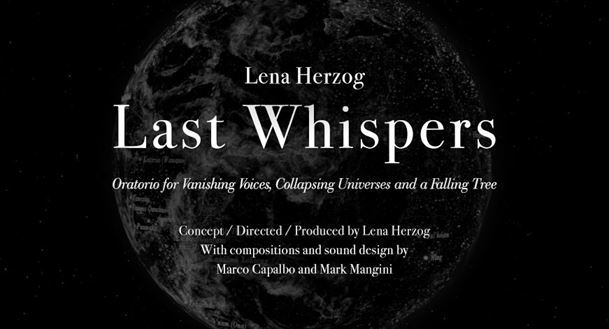The Alexander Kasser Theater brought “Last Whispers” for its Peak Performances debut at Montclair State University. This immersive oratorio, directed and produced by Lena Herzog, warns about the extinction of languages in the world, while also providing a visual to accompany the discussion.
Upon entering the theater on Wednesday, Oct. 16, I had no idea what to expect having never seen an oratorio before. The first half of the production began with a TED Talk-style discussion. The curator of culture and linguistic revitalization at the Smithsonian, Mary Linn, began with a rundown of how quickly languages of the world are fading away. She presented the audience with this information in the form of charts and maps to fully understand how quickly these languages were disappearing, as well as their locations.
As I came to terms with the fate of these languages, I felt sorrowful that there might be a world where no one would remember them.
Linn decided to take this day to show that there is still hope for these languages. She displayed the efforts that some people are taking to pass on what they know to others. One part of her speech that hit me the most was how recovering and preserving these languages are preventing suicide.
Linn expressed that as more languages are disappearing, there becomes a disconnect and leaves people feeling as though they are floating without any attachments to their culture or to who they are. It was interesting to hear that something like reconnecting with a language, or just exploring it, can cause a great impact such as this. It warmed my heart to know that there are people still actively trying to preserve the languages that connect them to who they are and their history.
The second half of the viewing was the full “Last Whispers” oratorio. For the most part, the end of any production would be the most impactful. But for me, it was the beginning.

“Last Whispers” is about the disappearance of languages around the world. Photo courtesy of Peak Performances
The screen showed hundreds of specks resembling stars, forming a map of the world. On the map were marked locations, displaying individual languages, each having a voice that spoke in that language. They all came together, overlapping each other. But soon they each faded out until only one remained until that too had fallen silent.
For me, it was the most emotional and haunting part of the production. It horrified me to realize that there could be a world where only a handful of languages remain, and I could already tell this experience would stick with me after that.
Visually, I was surprised to find that it focused mainly on camera views of forests and lakes. The shots were beautiful and had me feeling as though I was connected with the scenes that were displayed. As the camera soared overhead above the lake, I felt as if I were flying as well, watching the world from a monochrome lens.

“Last Whispers” was directed and produced by Lena Herzog. Photo courtesy of Peak Performances
Herzog’s idea was that she wanted the viewer to “float like a ghost” through these scenic landscapes, and this did just that, as I began to feel an almost out-of-body experience.
“Last Whispers” featured a small musical score, which mainly included bells and the beat of drums. It was faint and oftentimes distant from the whole show together, but when it came back it always gave me chills.
The most impactful part of the score were the voices, all spoken in a fading language, that made the entire show absolutely beautiful. Voices faded in and out of each other, some singing while others were only speaking. They came together and acted as a choir of voices, without any musical accompaniment. It was beautiful, yet haunting, as if these voices were crying out for help.
The entire show was a call to action, to educate people on how these languages are disappearing. It is an experience that will stay with me for a while and has inspired me to delve deeper into the different languages that exist in this world.
“Last Whispers” ran from Oct. 16 to Oct. 20, so hopefully you had the chance to catch this experience for yourself.



